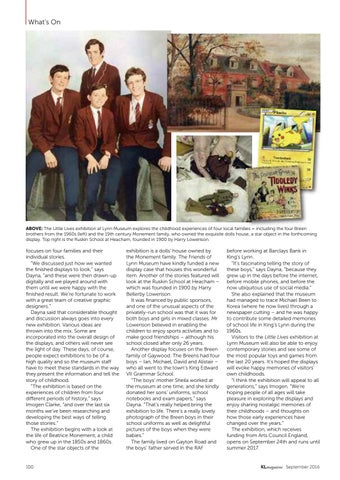What’s On
ABOVE: The Little Lives exhibition at Lynn Museum explores the childhood experiences of four local families – including the four Breen brothers from the 1960s (left) and the 19th century Monement family, who owned the exquisite dolls house, a star object in the forthcoming display. Top right is the Ruskin School at Heacham, founded in 1900 by Harry Lowerison.
focuses on four families and their individual stories. “We discussed just how we wanted the finished displays to look,” says Dayna, “and these were then drawn-up digitally and we played around with them until we were happy with the finished result. We’re fortunate to work with a great team of creative graphic designers.” Dayna said that considerable thought and discussion always goes into every new exhibition. Various ideas are thrown into the mix. Some are incorporated into the overall design of the displays, and others will never see the light of day. These days, of course, people expect exhibitions to be of a high quality and so the museum staff have to meet these standards in the way they present the information and tell the story of childhood. “The exhibition is based on the experiences of children from four different periods of history,” says Imogen Clarke, “and over the last six months we’ve been researching and developing the best ways of telling those stories.” The exhibition begins with a look at the life of Beatrice Monement, a child who grew up in the 1850s and 1860s. One of the star objects of the
100
exhibition is a dolls’ house owned by the Monement family. The Friends of Lynn Museum have kindly funded a new display case that houses this wonderful item. Another of the stories featured will look at the Ruskin School at Heacham – which was founded in 1900 by Harry Bellerby Lowerison. It was financed by public sponsors, and one of the unusual aspects of the privately-run school was that it was for both boys and girls in mixed classes. Mr Lowerison believed in enabling the children to enjoy sports activities and to make good friendships – although his school closed after only 26 years. Another display focuses on the Breen family of Gaywood. The Breens had four boys – Ian, Michael, David and Alistair – who all went to the town’s King Edward VII Grammar School. “The boys’ mother Sheila worked at the museum at one time, and she kindly donated her sons’ uniforms, school notebooks and exam papers,” says Dayna. “That’s really helped bring the exhibition to life. There’s a really lovely photograph of the Breen boys in their school uniforms as well as delightful pictures of the boys when they were babies.” The family lived on Gayton Road and the boys’ father served in the RAF
before working at Barclays Bank in King’s Lynn. “It’s fascinating telling the story of these boys,” says Dayna, “because they grew up in the days before the internet, before mobile phones, and before the now ubiquitous use of social media.” She also explained that the museum had managed to trace Michael Been to Korea (where he now lives) through a newspaper cutting – and he was happy to contribute some detailed memories of school life in King’s Lynn during the 1960s. Visitors to the Little Lives exhibition at Lynn Museum will also be able to enjoy contemporary stories and see some of the most popular toys and games from the last 20 years. It’s hoped the displays will evoke happy memories of visitors’ own childhoods. “I think the exhibition will appeal to all generations,” says Imogen. “We’re hoping people of all ages will take pleasure in exploring the displays and enjoy sharing nostalgic memories of their childhoods – and thoughts on how those early experiences have changed over the years.” The exhibition, which receives funding from Arts Council England, opens on September 24th and runs until summer 2017.
KLmagazine September 2016
